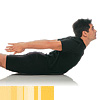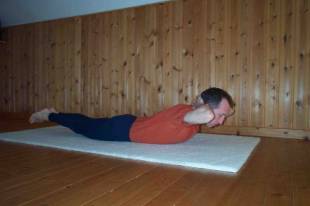Crocodiles, Sea Monsters, Dolphins & Locusts
If you've practiced locust pose, salabhasana, you know that as a part of a well-rounded yoga routine, this asana can really help folks with some types of low back pain.
The vertebrae in the low back, the lumbar region, are ideally aligned so that the curve is concave. If your hamstrings are snug, or if you do a lot of sitting, the top of your pelvis may regularly tip backwards. If you do this chronically, your low back starts to lose its natural indented curve.
Some folks end up with a flat lumbar spine or even one that bulges out. For many, this can be painful.
Locust pose can strengthen the low back and re-establish the natural, healthy curve.
 To do locust pose, you lie on your tummy and stretch your arms backwards along side your torso. Then lift your legs up off the floor, and your torso too. Keep the spine long and the tailbone tucked.
To do locust pose, you lie on your tummy and stretch your arms backwards along side your torso. Then lift your legs up off the floor, and your torso too. Keep the spine long and the tailbone tucked.
If you're new to back strengtheners like this, I don't recommend you begin with locust pose. Practice "baby" cobra poses and sphinx for a while, first.
Then, once you're comfortable with locust pose, you can progress on to a more challenging version of salabhasana called, makarasana. Makarasana looks just like locust pose except for the fact that the hands are clasped behind the head and the elbows are opened out to the sides.
Makarasana looks just like locust pose except for the fact that the hands are clasped behind the head and the elbows are opened out to the sides.
My last two Daily Yoga Tips have been about crocodiles, a theme prompted by Steve Irwin, the Crocodile Hunter.
Makarasana, like yesterday's pose, nakrasana, is also translated by many as "crocodile pose."
Yogacharya B.K.S. Iyengar calls makarasana the crocodile pose in his book Light on Yoga.
But many contend that this is a mistake, they believe, caused by the similarity of the two Sanskrit words.
 Some say that makarasana is more properly translated as "sea monster," "sea serpent," or "dolphin." Here's a picture of the legendary sea serpent carved in a sandstone roof beam.
Some say that makarasana is more properly translated as "sea monster," "sea serpent," or "dolphin." Here's a picture of the legendary sea serpent carved in a sandstone roof beam.
I'm no expert, so I can't solve this dilemma. But I can bring it to your attention so that you can use this controversy to make it more memorable.
Whether you remember the difference between makarasana and nakrasana won't change the fact that if you do makarasana your back will get stronger.
One thing's for sure, if you practice, you can master both crocodile poses, by any name.
Don't just read about it. Get up. Experience it. Experience yoga!
Kevin Perry
www.ExperienceYoga.org
p.s., The Sanskrit Word of the Day from my previous Daily Yoga Tip was makara. Makara, as you now know, means crocodile (or sea monster or dolphin), as in makarasana.
p.p.p.s., Today's Sanskrit Word of the Day is ananda. I'll tell you what it means next time, when I tell you a little bit more about anandamide.
p.p.p.p.s., My knee felt great all day today, until the local pain med wore off at about 3 pm. Oh well. I'm up and moving around with a cane. And so far the swelling has stayed down.
I received a great request yesterday to write about yoga poses that can be particularly rough on the knees. Stay tuned. It's a great topic. I'll get to it later this week.
p.p.p.p.p.s., Our Experience Paradise yoga vacation in Yelapa, Mexico is coming up in February, 2007. Watch for more details in future Daily Yoga Tips. If you're curious take a look here for just a taste of things to come.
Copyright 2006. All rights reserved, Mo Yoga LLC.
Kevin Perry
Mo Yoga LLC
1305 Elmerine Ave
Jefferson City, MO 65101
(573) 680-6737
The vertebrae in the low back, the lumbar region, are ideally aligned so that the curve is concave. If your hamstrings are snug, or if you do a lot of sitting, the top of your pelvis may regularly tip backwards. If you do this chronically, your low back starts to lose its natural indented curve.
Some folks end up with a flat lumbar spine or even one that bulges out. For many, this can be painful.
Locust pose can strengthen the low back and re-establish the natural, healthy curve.
 To do locust pose, you lie on your tummy and stretch your arms backwards along side your torso. Then lift your legs up off the floor, and your torso too. Keep the spine long and the tailbone tucked.
To do locust pose, you lie on your tummy and stretch your arms backwards along side your torso. Then lift your legs up off the floor, and your torso too. Keep the spine long and the tailbone tucked.If you're new to back strengtheners like this, I don't recommend you begin with locust pose. Practice "baby" cobra poses and sphinx for a while, first.
Then, once you're comfortable with locust pose, you can progress on to a more challenging version of salabhasana called, makarasana.
 Makarasana looks just like locust pose except for the fact that the hands are clasped behind the head and the elbows are opened out to the sides.
Makarasana looks just like locust pose except for the fact that the hands are clasped behind the head and the elbows are opened out to the sides.My last two Daily Yoga Tips have been about crocodiles, a theme prompted by Steve Irwin, the Crocodile Hunter.
Makarasana, like yesterday's pose, nakrasana, is also translated by many as "crocodile pose."
Yogacharya B.K.S. Iyengar calls makarasana the crocodile pose in his book Light on Yoga.
But many contend that this is a mistake, they believe, caused by the similarity of the two Sanskrit words.
 Some say that makarasana is more properly translated as "sea monster," "sea serpent," or "dolphin." Here's a picture of the legendary sea serpent carved in a sandstone roof beam.
Some say that makarasana is more properly translated as "sea monster," "sea serpent," or "dolphin." Here's a picture of the legendary sea serpent carved in a sandstone roof beam.I'm no expert, so I can't solve this dilemma. But I can bring it to your attention so that you can use this controversy to make it more memorable.
Whether you remember the difference between makarasana and nakrasana won't change the fact that if you do makarasana your back will get stronger.
One thing's for sure, if you practice, you can master both crocodile poses, by any name.
Don't just read about it. Get up. Experience it. Experience yoga!
Kevin Perry
www.ExperienceYoga.org
p.s., The Sanskrit Word of the Day from my previous Daily Yoga Tip was makara. Makara, as you now know, means crocodile (or sea monster or dolphin), as in makarasana.
p.p.p.s., Today's Sanskrit Word of the Day is ananda. I'll tell you what it means next time, when I tell you a little bit more about anandamide.
p.p.p.p.s., My knee felt great all day today, until the local pain med wore off at about 3 pm. Oh well. I'm up and moving around with a cane. And so far the swelling has stayed down.
I received a great request yesterday to write about yoga poses that can be particularly rough on the knees. Stay tuned. It's a great topic. I'll get to it later this week.
p.p.p.p.p.s., Our Experience Paradise yoga vacation in Yelapa, Mexico is coming up in February, 2007. Watch for more details in future Daily Yoga Tips. If you're curious take a look here for just a taste of things to come.
Copyright 2006. All rights reserved, Mo Yoga LLC.
Kevin Perry
Mo Yoga LLC
1305 Elmerine Ave
Jefferson City, MO 65101
(573) 680-6737


2 Comments:
Thank you so much for your great sharing.I like the writing format.I also planning to write this type blog with the help of your post.
I hope this website you manage to be the best and be number one. Thank you for sharing and I hope this website you manage to be the best. Custom Essay Writing Service
Post a Comment
<< Home